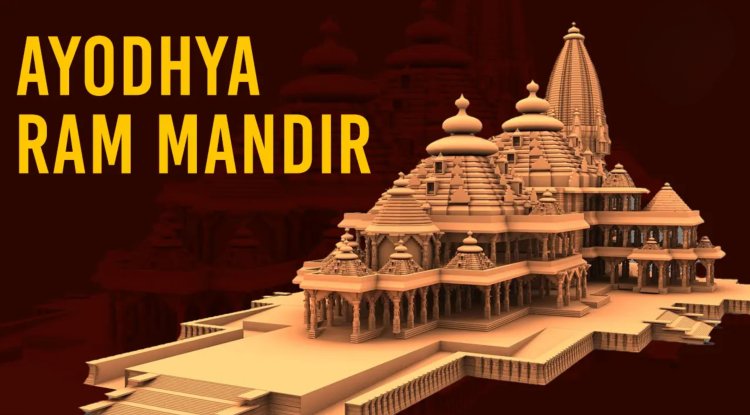Ram Mandir: A Saga of Devotion, Dispute, and Rebirth
The narrative of Ram Mandir intertwines with the epic Ramayana, where Ayodhya is described as the birthplace of Rama, the seventh avatar of Vishnu. Hindu tradition holds that a magnificent temple stood at this site until the 16th century. In 1528, Mughal emperor Babur demolished the temple and built the Babri Masjid on its ruins. This marked the beginning of a long and complex dispute that would shape India's socio-religious landscape.

The Ram Mandir in Ayodhya is not just a structure of stone and mortar; it's a living testament to the unwavering faith, tumultuous conflicts, and eventual hope that have resonated through Indian history. To truly understand its present and future, we must delve deeper into the intricate tapestry of its past, where ancient whispers meet the echoes of modern struggles.

Ancient Echoes: Whispers of Rama's Birthplace
Legend whispers of a magnificent temple in Ayodhya, bathed in the golden light of a bygone era. This grand edifice, dedicated to Lord Rama, the revered deity of the Ramayana, stood as a beacon of faith for Hindus. Archaeological and textual evidence suggests its existence for centuries, echoing Rama's birth as described in the epic. For countless devotees, this was more than just a temple; it was the very embodiment of their divine hero, the physical manifestation of their spiritual belief.
Mughal Interruption: Cracks in the Foundation of Faith
In 1528, the tranquil murmurs of devotion were shattered by the drums of war. Babur, the founder of the Mughal Empire, marched into Ayodhya, leaving a trail of destruction in his wake. The magnificent Ram Mandir was demolished, a symbol of Hindu faith replaced by the Babri Masjid, a testament to Mughal authority. This act, etched in stone and sorrow, sowed the seeds of an age-old dispute, a wound that would fester for centuries.
Seeds of Sowing: The Rise of the Ram Janmabhoomi Movement
For centuries, the Babri Masjid stood as a stark reminder of the lost temple. Though murmurs of discontent existed, it wasn't until the late 20th century that these murmurs transformed into a roar. The 1980s witnessed the rise of the Ram Janmabhoomi movement, fueled by rising Hindu nationalism. The Vishva Hindu Parishad (VHP) emerged as the champion of reclaiming the birthplace of Rama, igniting a nationwide campaign that resonated with millions.
Escalating Tensions: 1980s, A Crucible of Disquiet
The 1980s were a decade of simmering tensions and escalating demands. The VHP's campaign gained momentum, attracting mass support and generating media attention. In 1984, Rajiv Gandhi's government allowed Hindus to perform symbolic religious rites at the disputed site, adding fuel to the already simmering fire. The stage was set for a tragic climax.
The Turning Point: December 6, 1992, A Day Etched in Blood
The 6th of December, 1992, remains a black mark on India's history. On that fateful day, Hindu kar sevaks, fueled by years of simmering grievances, stormed the Babri Masjid, demolishing the structure in a frenzy of religious fervor. This act of desecration triggered widespread communal riots across the nation, leaving over 2,000 dead and countless lives scarred. The Ram Mandir issue, once a political dispute, became a stark symbol of communal fault lines.
Legal Battles and a Long-Awaited Verdict: Hope Amidst the Ashes
The aftermath of the Babri Masjid demolition was a period of legal battles and intense social scrutiny. For almost three decades, the Supreme Court of India became the arbiter of a nation's anxieties. Finally, in November 2019, the long-awaited verdict arrived. The court awarded the disputed land to a Hindu trust for the construction of Ram Mandir, while allocating an alternate site for a mosque. This verdict, though met with mixed reactions, offered a glimmer of hope for closure and reconciliation.
Foundations Laid: A New Dawn Breaks in Ayodhya
With the legal hurdles surmounted, the construction of Ram Mandir commenced in August 2020. Prime Minister Narendra Modi himself laid the foundation stone, marking a monumental moment in Indian history. The grand project, estimated to be completed by 2024, promises to be a breathtaking spectacle of traditional Hindu architecture and modern engineering prowess.
Beyond Bricks and Mortar: The Significance of Ram Mandir
Ram Mandir's significance transcends the physical realm. It's a symbol of resilience, a testament to the unwavering faith of millions of Hindus who fought for their sacred ground. It signifies a closure to a long and painful chapter in India's history, offering hope for communal harmony and social healing. However, the road ahead requires navigating sensitive terrains. Ensuring inclusivity and respect for all faiths will be crucial to maintain the spirit of peace and reconciliation.
Challenges and Hope: Navigating the Future of Ram Mandir
Ram Mandir's construction may have begun, but the journey towards true harmony is far from over. There are still those who hold dissenting views on the temple's construction and the events that led to it. It is crucial to respect all viewpoints and engage in meaningful dialogue to ensure that the Ram Mandir story becomes a bridge between communities, rather than a dividing line.
Reconciliation and Inclusivity: Building Bridges, Not Walls
The sensitive nature of the Ram Mandir issue necessitates a spirit of understanding and inclusivity. While the temple holds immense significance for Hindus, acknowledging the pain and hurt caused to the Muslim community during the Babri Masjid demolition is crucial. Building a mosque at the alternate site allocated by the Supreme Court is a commendable step towards reconciling past grievances and promoting interfaith harmony.
Education and Tolerance: Dispelling Myths and Misinformation
Misinformation and historical distortions have played a significant role in fueling tensions around the Ram Mandir issue. Promoting comprehensive education about the temple's history, the legal proceedings, and the perspectives of different communities is crucial. This will help dispel myths, foster understanding, and prevent the manipulation of religious sentiments.
Celebrating Shared Heritage: Embracing Unity in Diversity
India's rich cultural tapestry is woven with threads of diverse faiths and traditions. Ram Mandir, with its roots in ancient epics and its contemporary significance, can serve as a platform for celebrating this shared heritage. Interfaith dialogues, cultural exchanges, and joint pilgrimages can foster a sense of unity and respect for each other's beliefs, transcending the historical discord.
Beyond Ayodhya: Ram Mandir's Global Impact
The Ram Mandir's construction and the associated social discourse have resonated with the Indian diaspora across the globe. It has sparked conversations about faith, identity, and the complexities of postcolonial history. Engaging with global audiences in an open and informative manner can promote a nuanced understanding of the issue and its implications beyond India's borders.
Ram Mandir: A Beacon of Hope in a Turbulent World
While the story of Ram Mandir is etched in conflict and controversy, it also offers a glimmer of hope for a brighter future. The successful construction and eventual consecration of the temple can become a symbol of peace, reconciliation, and acceptance. It can serve as a testament to the human spirit's ability to heal, forgive, and build bridges even amidst the ruins of discord.
Ultimately, Ram Mandir stands as a reminder that faith, when accompanied by understanding and tolerance, can become a powerful force for good. Its present construction and future legacy represent an opportunity to move beyond the shadows of the past and embrace a future of harmony and mutual respect, not just in Ayodhya, but across India and beyond.
Epilogue: Beyond Bricks and Mortals
The story of Ram Mandir is not simply about bricks and mortar; it is about the human spirit, its triumphs and tribulations, its resilience and capacity for hope. As the temple rises in Ayodhya, may it stand not just as a testament to faith, but also as a beacon of unity, reminding us that the greatest victories are those won not in battles, but in hearts and minds.
Ram Mandir: A Saga of Devotion, Dispute, and Renewal - Updates from 2024
The story of Ram Mandir, a magnificent temple dedicated to Lord Rama rising in Ayodhya, continues to resonate throughout India and beyond. Since our last exploration, significant developments have unfolded, shaping the temple's construction, its social impact, and its place in India's future. Let's dive into these recent updates:
Construction Progress:
-
Accelerated Pace: As of January 21, 2024, the construction of Ram Mandir is progressing swiftly. With the deadline of December 2024 set, work is moving at a faster pace than initially anticipated.
-
Three Floors Completed: The ground, first, and second floors of the temple have already been completed, with work on the third floor currently underway. The intricate carvings and sculptures adorning the exterior walls are taking shape, showcasing the skill and artistry of Indian craftsmen.
Increased Security:
- VIP Visit Preparations: With the approaching inauguration date, security measures around the temple complex have been significantly tightened. Anti-terror precautions and enhanced surveillance are in place to ensure a smooth and secure event.
Guest List Controversy:
-
Political Tensions: The invitation list for the Ram Mandir inauguration has become a topic of debate, with some political leaders expressing their displeasure at not being included. This has highlighted the ongoing political sensitivities surrounding the temple.
-
Focus on Inclusivity: Organizers have emphasized their commitment to an inclusive ceremony, inviting religious leaders from all faiths and dignitaries from various countries.
Social Impact:
-
Economic Boost: The Ram Mandir project has provided a significant economic boost to Ayodhya. With increased tourism and development opportunities, the city is witnessing a revival.
-
Interfaith Dialogue: The Ram Mandir's construction has also sparked conversations about interfaith dialogue and reconciliation. Several initiatives are underway to promote understanding and respect between different communities.
Global Perspectives:
- International Attention: The Ram Mandir story continues to attract international attention, with media outlets across the world highlighting its cultural and religious significance. This has opened up opportunities for cultural exchange and international understanding.
Challenges and Opportunities:
-
Managing Expectations: With the heightened anticipation surrounding the inauguration, managing public expectations will be crucial. Ensuring a smooth and inclusive ceremony while respecting the sentiments of all communities is a delicate task.
-
Maintaining Harmony: Beyond the inauguration, the long-term challenge lies in ensuring that the Ram Mandir remains a symbol of unity and harmony, fostering interfaith dialogue and social cohesion.
Ram Mandir's future holds immense potential to be a beacon of hope, not just for Ayodhya and India, but for the world. By fostering tolerance, understanding, and respect for diverse faiths and perspectives, this magnificent temple can stand as a testament to the enduring power of faith and its ability to unite us in our shared humanity.
Let the Ram Mandir saga be a testament to the enduring power of peace, understanding, and the timeless dream of a world where faith becomes a bridge, not a wall.
What's Your Reaction?



















